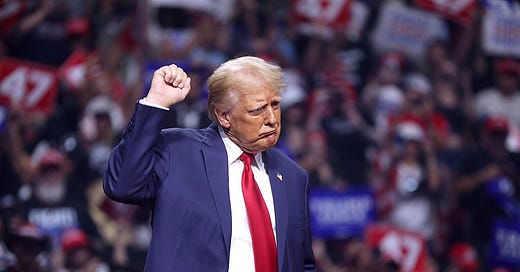April 11, 2025: Trump’s tariff two-step
In which, Trump’s tariff’s bite… until they don’t. Or, economic statesmanship and great power competition in an age of unstable multipolarity.
Trump’s tariff two-step

The tariff’s were on… until they weren’t.
The markets were bad… until they weren’t… until they weren’t…
And around and around we go.
Last week, markets were reeling, and friend and foe alike were divided on how to approach the Trump administration’s paradigmatic policy shift on trade.
Democrats weren’t sure whether to damn the tariffs or embrace them. Trump’s cabinet was divided on whether the tariffs were a negotiable leveraging device or a permanent fixture. The only country sure on where things stood was China who took up the trade war gauntlet, returned fire, and got punched back in return.
I gotta admit, calling the play by play on this, is pretty wild.
While many blame market volatility on Trump’s “to tariff or not to tariff” approach to trade and the diplomacy surrounding it, I can’t help but wonder if the market volatility is not also a function of the total breakdown of the so-called “Washington consensus” on trade. If markets are trying to anticipate economic trends and directions, but there isn’t any agreement at the policy level on what that new direction is or will be, well… seems like you’ll get some volatility.
So, what happened exactly? Why did Trump pull back on tariffs? Was it because markets were driving off the recession cliff? Was it because phones were ringing off the hook at Commerce and Treasury requesting negotiation? Was it because people were ready to strike Faustian bargains with China? All of the above?
These possibilities were all there, but the degree to which they weighed in the decision making of President Trump seems to be something of an unknown and likely says more about the pundit doing the observing than the President being observed.
So where tariffs now stand? The 90-day tariff pause (sans China) announced this week came as dozens of countries (75 at last count) contacted the administration to renegotiate trade deals; the EU and China have both announced retaliatory tariffs; and the debate continues on the possibility of recession in the US. Where are things going to land? Unclear, but here’s a few things to keep in mind going forward:
There are essentially three categories of tariffs we’re dealing with here:
A baseline 10% tariff on all imports that appears to be nonnegotiable.
Reciprocal tariffs that appear to be variable and up for negotiation.
China tariffs.
These different categories have different purposes:
10% baseline tariffs to increase revenue.
Reciprocal tariffs to protect/reinvigorate American manufacturing (as they have done for numerous countries), rebalance trade deficits, and court foreign investment.
China tariffs to compete with China and prevent Beijing from seizing the lead on future tech.
If that assessment is correct, I think we can anticipate a few things:
The China trade war is on and not going anywhere.
While the EU has announced retaliatory tariffs, it’s highly likely that a negotiated trade deal will emerge with the EU, especially since countries like Italy and Greece are pushing for lower trade barriers with the US.
With inflation staying down, the possibility of the 2017 tax cuts being made permanent in the just passed budget bill (see below), and the Supreme Court giving the Trump cover on allowing DOGE to continue its work, recession fears may be overblown as economic dynamism absorbs and overcomes any price increases on consumer goods.
Bottom line: It won’t be overnight, but by the end of this year, we could very well be in a much better economic position.
One final thought: If we’re living in a world system of “unbalanced multipolarity” (some call it “uneven multipolarity” as well) characterized by great power competition, then it would seem to make sense that you ensure your economic supply chains run through domestic and/or friendly international entities, and that you further take steps to protect your economy from adversarial economic warfare. In other words, trade policy amidst great power competition in an unbalanced multipolar system should look very much like what the Trump administration is doing.
Keep reading with a 7-day free trial
Subscribe to Tim Talks Politics to keep reading this post and get 7 days of free access to the full post archives.



